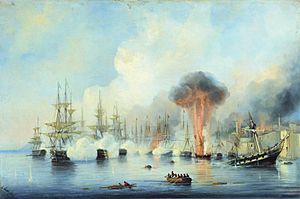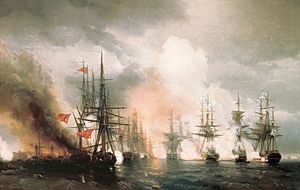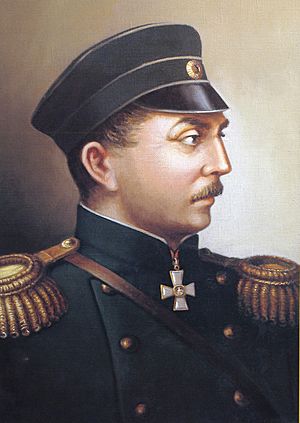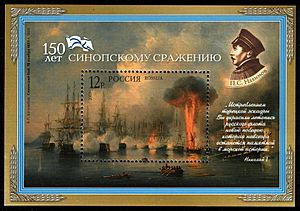Battle of Sinop facts for kids
Quick facts for kids Battle of Sinop |
|||||||
|---|---|---|---|---|---|---|---|
| Part of the Crimean War | |||||||
 The Battle of Sinop by Alexey Bogolyubov |
|||||||
|
|||||||
| Belligerents | |||||||
| Commanders and leaders | |||||||
| Strength | |||||||
| 6 ships of the line, 2 frigates, 3 steamers |
7 frigates, 3 corvettes, 2 steamers |
||||||
| Casualties and losses | |||||||
| 37 killed, 229 wounded |
3,000 killed 1 frigate sunk, 1 steamer sunk, 6 frigates grounded, 3 corvettes grounded, ~2 shore batteries destroyed |
||||||
The Battle of Sinop was a major sea battle that happened on November 30, 1853. It was fought between the Russian Empire and the Ottoman Empire (which is now Turkey). This battle was one of the first big events of the Crimean War (1853–1856).
The fight took place at Sinop, a port city on the southern coast of the Black Sea. A group of Russian warships attacked and completely defeated an Ottoman fleet that was anchored in Sinop's harbor. The Russian fleet had six large warships called ships of the line, two smaller frigates, and three steamers (ships powered by steam). They were led by Admiral Pavel Nakhimov. The Ottoman fleet had seven frigates, three corvettes (smaller warships), and two steamers, led by Vice Admiral Osman Pasha.
The Russian navy had recently started using new cannons that fired explosive shells. These shells exploded when they hit a target, which was a huge advantage. All the Ottoman frigates and corvettes were either sunk or had to be run aground (pushed onto the shore) to avoid sinking. Only one Ottoman steamer managed to escape. The Russians did not lose any ships. Sadly, about 3,000 Ottoman sailors were killed.
This big Russian victory helped convince France and Britain to join the war. They sided with the Ottomans against Russia. The battle also showed how powerful explosive shells were against wooden ships. It led to navies around the world using more explosive artillery and eventually developing ironclad warships (ships covered in metal armor).
Contents
Why the Battle Happened

The Battle of Sinop happened about two months after the Ottoman Empire declared war on Russia. This was on October 4, 1853. The Ottomans declared war because Russia had moved its troops into some Ottoman areas called Moldavia and Wallachia.
In the 1850s, the Ottoman Empire was in a lot of debt. It depended on loans from Britain and France. Because of this, Ottoman leaders had to greatly reduce their army and navy. The Russian ruler, Tsar Nicholas I, saw this as a chance to expand Russia's power. He wanted to gain control in the Trans-Caucasus region and along the Danube River.
In July 1853, Russian forces occupied several Ottoman areas along the Danube. Talks to solve the problems failed. So, the Ottoman Sultan Abdulmecid I declared war. Britain and France were worried about Russia getting too powerful. They told Russia to only fight defensively. If Russia attacked, they warned they might get involved.
Fighting officially began on October 4. There were battles in Europe and in the Caucasus region. Sultan Abdulmecid ordered an attack to push back the Russians. He wanted to show the Ottoman Empire was still strong. The Ottoman land attack in the Russian Caucasus was quite successful. By late October, the Russian army there was in danger of being surrounded.
Before the Big Fight
The sea part of the war was quiet until November. Then, Vice Admiral Osman Pasha's fleet had to stop at Sinop during a storm. Sultan Abdulmecid wanted to send supplies to his army in Georgia. He ordered a group of frigates, steamers, and transport ships to create a supply route.
Osman Pasha was on his ship, the 60-gun Avni Illah. He was sailing with seven frigates, two corvettes, and several transport ships. They were going to resupply the Ottoman land forces. But it was late November, and the fleet had to find a place to stay for the winter. They ended up in Sinop. They joined another frigate, Kaid Zafer, and the steam frigate Taif. The Ottomans had wanted to send even bigger warships to Sinop. But the British ambassador in Constantinople (now Istanbul) disagreed. So, only frigates were sent.
At first, Russian ships stayed in Sevastopol. But as the Russian army in the Caucasus faced problems, Russia had to act. Admiral Pavel Nakhimov was ordered to gather the Russian navy. He was told to stop the Ottomans. From November 1 to 23, Russian ships were sent into the Black Sea to take control. Two Ottoman steamers were captured by the Russians. Russia gained control of the sea routes. But storms forced Nakhimov to send most of his ships back for repairs.
Nakhimov was left with only one frigate, one steamer, and three ships of the line. He continued searching for Osman's fleet. On November 23, Osman's ships were seen entering Sinop harbor. Nakhimov immediately blocked the harbor. He sent his frigate to get more Russian ships as fast as possible.
On November 30, Vice Admiral Fyodor Novosiliski brought six more ships to Nakhimov. This completed the blockade of Sinop harbor. More steamers were expected, but Nakhimov decided to attack before the Ottomans could get more ships. Osman knew the Russians were there since November 23. But he thought his ships were safe in the harbor. Sinop had strong harbor defenses and forts with many cannons. Osman did not try to break the weak Russian blockade. He even let many of his sailors go ashore.
The Battle Begins
Admiral Nakhimov and his officers decided to attack the Ottoman fleet. The Russian fleet was made much stronger by Vice Admiral Novosilsky's ships. Nakhimov now had over 700 cannons on six ships of the line, two frigates, and three armed steamers. The Ottoman forces had seven frigates, three corvettes, and two armed steamers.
The Russians planned to sail their ships in two lines. They would get very close to the enemy ships. Then they would drop anchor and start firing. Nakhimov's 84-gun ship, Imperatritsa Maria, was the first to attack. It fired on the 44-gun Ottoman flagship, Auni Allah.
On November 30, the Russian ships entered the harbor. Nakhimov moved his fleet so that the Ottoman ships were caught between the Russian ships and Sinop's shore defenses. This protected the Russian ships and put the Ottomans in danger of being hit by their own shore cannons. Russian gunners started hitting all the Ottoman ships.
The new projectile shells fired from Russian guns immediately set the wooden Ottoman ships on fire. Sailors panicked and found it hard to put out fires. After about 30 minutes, the Ottoman flagship Auni Allah was badly damaged. It ran aground when its anchor cable was cut. The Imperatritsa Maria then attacked and disabled the 44-gun frigate Fazli Allah, which caught fire. Other Russian ships damaged the Nizamie and Damiad. The Ottoman corvette Guli Sephid and frigate Navek Bakhri exploded.
Only one Ottoman ship, the 12-gun paddle frigate Taif, managed to escape the battle. All the other Ottoman ships were either sunk or purposely run ashore. The Taif fled to Istanbul and arrived on December 2. It told the Ottoman government and the British Royal Navy about the defeat.
After destroying the enemy fleet, the Russians attacked and destroyed the Ottoman shore batteries. During the battle, 37 Russians were killed and 229 were wounded. At least three Russian ships were damaged. Ottoman forces lost about 3,000 men killed. 150 were taken prisoner, and their leader Osman Pasha was captured.
What Happened Next
When news of the battle reached Russia, people were very happy. The Russian navy, which many people didn't trust, had won a big victory. This made the money spent on developing the navy seem worthwhile. There were parties and a parade to celebrate the victory. Military experts saw the battle as very important. They pushed for shell-firing guns to be put on all Russian ships.
In the Ottoman capital of Constantinople (Istanbul), people were worried or even panicked. Russia had destroyed a key supply fleet. Now Russia controlled the Black Sea. The destruction of the harbor defenses meant Russia could invade. The entire coast was now at risk. Also, Russia's actions seemed to go against what Britain and France had said. This meant Russia might not hold back anymore.
The attack was seen by other countries as unfair. It caused a lot of anti-Russian feelings in Western Europe. Much of the British news called the attack the "Massacre of Sinope." The attack made the groups in Britain and France who wanted war stronger. It gave them a reason to go to war to stop Russia. By March 1854, Britain and France decided to declare war on Russia. Sinop was seen as a fair reason for war. But the real reason was to stop Russia from expanding and keep a balance of power in Europe.
During the Crimean War that followed, all the Russian ships that fought in the Battle of Sinop were later lost at Sevastopol.
The Battle of Sinop was presented by the media as more of an ambush than a fair fight. But its results were very important for how naval battles were fought in the 1800s. Before Sinop, most naval cannons fired solid cannonballs. These cannonballs could damage ships, but they didn't explode.
New cannons, like the Paixhans guns, were slowly being added to navies. Only the French, Russian, and American navies had made a big effort to use them. These new cannons were a huge step forward in naval technology. Unlike older cannons, Paixhans guns fired explosive shells. These shells caused both physical damage and fires. The new guns were also heavier, could shoot farther, and had much more power to break through ship hulls.
However, before 1853, no navy had used shell-firing guns in a real battle in a big way. Many experts even thought these new weapons were too heavy for warships. The results of Sinop were very clear: the new weapons were extremely effective. Because of this, countries started a race to improve their ships. They wanted to add shell-firing guns to existing ships and build new ironclad vessels (ships protected by metal armor).
Ships in the Battle

Russian Empire Ships
- Velikiy Knyaz Konstantin, a ship of the line, with 120 guns
- Tri Sviatitelia, a ship of the line, with 120 guns
- Parizh, a ship of the line, with 120 guns (this became the main ship)
- Imperatritsa Maria, a ship of the line, with 84 guns (this was the admiral's ship)
- Chesma, a ship of the line, with 84 guns
- Rostislav, a ship of the line, with 84 guns
- Kulevtcha, a frigate, with 54 guns
- Kagul, a frigate, with 44 guns
- Odessa, a steamer, with 4 guns
- Krym, a steamer, with 4 guns
- Khersones, a steamer, with 4 guns
Ottoman Empire Ships
- Avni Illah, a frigate, with 44 guns (it ran aground)
- Fazl Illah, a frigate, with 44 guns (it burned and ran aground)
- Nizamieh, a frigate, with 62 guns (it ran aground after losing two masts)
- Nessin Zafer, a frigate, with 60 guns (it ran aground after its anchor chain broke)
- Navek Bahri, a frigate, with 58 guns (it exploded)
- Damiat, a frigate, with 56 guns (from Egypt, it ran aground)
- Kaid Zafer, a frigate, with 54 guns (it ran aground)
- Nejm Fishan, a corvette, with 24 guns
- Feyz Mabud, a corvette, with 24 guns (it ran aground)
- Kel Safid, a corvette, with 22 guns (it exploded)
- Taif, a paddle frigate, with 30 guns (it escaped to Istanbul)
- Erkelye, a steamer, with 10 guns




